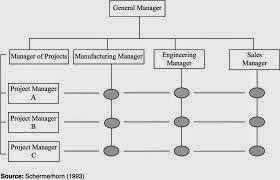ADVANTAGES AND DISADVANTAGES OF MATRICES ORGANIZATION STRUCTURE
A
matrix organizational structure is one of the most complicated reporting
structures a company can implement. Read on to learn why a company might
implement a matrix structure, and the advantages and disadvantages for both
company and staff.In another way it is a company structure in which the reporting
relationships are set up as a grid, or matrix, rather than in the traditional
hierarchy. In other words, employees have dual reporting relationships -
generally to both a functional manager and a product manager.
Examples of Matrix
Organizational Structures
In
the 1970s, Philips, a Dutch multinational electronics company, set up matrix
management with its managers reporting to both a geographical manager and a
product division manager. Many other large corporations, including Caterpillar
Tractor, Hughes Aircraft, and Texas Instruments, also set up reporting along
both functional and project lines around that time.
Advantages
In
a matrix organization, instead of choosing between lining up staff along
functional, geographic or product lines, management has both. Staffers report
to a functional manager who can help with skills and help prioritize and review
work, and to a product line manager who sets direction on product offerings by
the company. This structure has some advantages:
1. Resources can be used
efficiently.
2. Products and projects
are formally coordinated across functional departments.
3. Information flows both
across and up through the organization.
4. Employees are in contact
with many people, who helps with sharing of information and can speed the
decision process.
5. Staffers have to work
autonomously and do some self-management between their competing bosses; this
can enhance motivation and decision making in employees who enjoy it.
Disadvantages
The
matrix structure is generally considered the toughest organizational form to
work in, due to the conflicting pulls on resources. The overlaps can lead to
turf battles, and difficulty in determining accountability. The major
disadvantages of a matrix structure are:
i.
Staffers have to make their own decisions about work
prioritization when their two managers have given them competing priorities.
ii.
It can be difficult to determine who is responsible for operating
financial results, and the dual reporting relationships make cost accounting
difficult.
iii.
The additional layer of overhead caused by the second set of
managers increases costs.
iv.
The frequent changes in reporting relationships as product
priorities change and staffers are assigned to new products can be difficult
for staff. These changes can disrupt working relationships, and lead to
start-up losses as working relationships are redefined.
v.
The overlapping reporting relationships can lead to power
struggles for resources. There may also be delayed reaction time when
responding to market changes due to the number of people who have to be
involved in the decision.
Hence,
the matrix organizational structure arose from companies looking for a way to
meet their needs in terms both of functional support and product focus. In this
structure, most team members have two bosses - one a functional or geographic
manager, and the other a product or business line manager. There are advantages
in terms of efficient use of resources across products and communication moving
in multiple directions across the organization, but a potential big
disadvantage is that employees have to manage competing priorities from two
different chains of command.


Comments